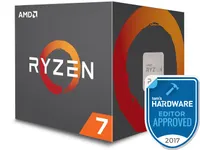How To Overclock AMD Ryzen CPUs
Memory Performance
Overclocking the execution cores is limited by available headroom. But if you really want to improve this platform's effectiveness, you cannot overlook the memory bus.
We begin by illustrating the gains achievable by moving from DDR4-2400 to -3200. On our Crosshair VI Hero, the 2400 MT/s is actually the default. On other motherboards, it may be lower (and not without consequence).
Cinebench R15
This test is not sensitive to memory bandwidth or latency, so the gains we measure should be trivial. Still, the influence of RAM performance is quantifiable, given a ~1.4% improvement.
| Configuration | Score |
|---|---|
| 2400 | 1639 |
| 3200 | 1663 |
Geekbench 4
This test stresses both the host processor and memory subsystem. Its single- and multi-core metrics reveal a performance increase of 5 and 6% from dialing in a faster data rate. That's quite a gain from simply modifying a multiplier setting, and memory capable of supporting 3200 MT/s isn't extremely expensive. Again, our Geekbench 4 scores are an average of three consecutive runs.
| Configuration | Single-Core | Multi-Core | Mem. Copy | Mem. Latency | Mem. Bandwidth |
|---|---|---|---|---|---|
| 2400 | 4417 | 20786 | 6229 | 4697 | 5568 |
| 3200 | 4635 | 22150 | 7546 | 5651 | 7094 |
Time Spy
Graphics-bound workloads don't benefit as much from a memory bandwidth increase. We do measure a gain in the overall score, but it's very small. Conversely, the CPU-oriented benchmark jumps by 343 points.
| Configuration | Graphics | CPU | Score |
|---|---|---|---|
| 2400 | 7204 | 8010 | 7314 |
| 3200 | 7217 | 8353 | 7367 |
MORE: How to Overclock a CPU
Get Tom's Hardware's best news and in-depth reviews, straight to your inbox.
Current page: Memory Performance
Prev Page 1800X: Maximum Overclock & Scaling Next Page BCLK Frequency-
drinkingcola86 Page 4 third paragraph.Reply
"Also, we observed that this this offset of 20°C is a loose approximation,"
Needs correcting. One "this." -
jkhoward Dang-it guys. The 1080 doesn't freaking work well with the new AMD CPU. You know this. Why would you not choose an AMD card? Trying to make AMD look bad again?Reply
<edited for language> -
MeanMachine41 Reply19647716 said:Dang-it guys. The 1080 doesn't freaking work well with the new AMD CPU. You know this. Why would you not choose an AMD card? Trying to make AMD look bad again?
<edited for language>
I have evidence to the contrary and the GTX-1080 works well with new Ryzen 7 1800X.
-
Kenneth_72 AMD's is missing it's opportunities. They better start hitting the ground running if they want to compete AND WE NEED THEM TO COMPETE!Reply -
JamesSneed For anyone looking to OC Ryzen this video from an AMD engineer is pretty interesting.Reply
https://www.youtube.com/watch?v=vZgpHTaQ10k
